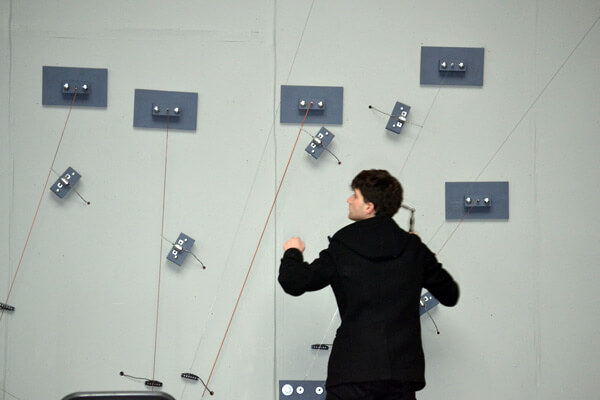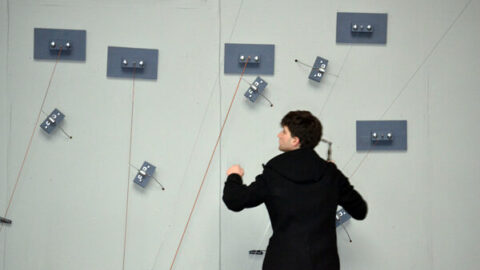Can you tell us more about your new piece, L-Carrier, that premieres on June 7 at Eyebeam?
I’m really excited to be putting this new piece up. It will be running for 2 weeks, June 7 – 23, with an octet playing as part of the opening. The installation component is large-scale, using extended strings ranging in length from 3 to about 70 feet long going across the space, overlapping and twisting around each other installed into the two-story high ceiling. The strings are struck by motorized beaters, which are run by a mechanical micro-controller system. Also, solenoids will be scattered around the space, which will make percussive attacks and crisp sounds in contrast to the harmonic sustain from the tuned strings.
The piece is built using an intertwined feedback system, which is based on a portfolio of images that are reordering and moving on a remote website. These images trigger patterns in the installation’s mechanical system. When people view the website, it sends information to the installation as to how to work the patterns. The system begins with a security camera close up on one of the strings triggering the start of the patterns (portfolio) on the website; in turn, it cues the motors to strike the strings. So in total, the strings are cuing the patterns, which are cuing the strings. The whole system is activated by itself. The site displaying the operating patterns, the surveillance video and an audio feed of the installation is hosted at turbulence.org starting June 7.

In addition to the visual portfolio portion of the score (which is images connected to code), the score includes a more conventionally notated ensemble piece written for an octet featuring cello (Alex Waterman), viola (Cat Lamb), violin (C. Spencer Yeh), alto saxophone (Ashley Paul), organ (Anthony Coleman), bassoon (Reuben Son), guitar (Geoff Mullen), and myself on drums and bowed percussion. The piece is a simultaneously a stand-alone mechanical installation, visual portfolio, feedback/networked system and an ensemble composition that is layered and interconnected in terms of what affects what – which was one of the appeals to me.
The title came out upon my reading about older methods of military communication, and cold war era technology. Specifically the idea of having complex webs of communication that are surrounding our lives, and not really understanding how they affect us. The layers of confusion that come about when thinking about an information network, as we deal with all the time in technology, seemed appropriate to the multiple levels of this piece and how they are feeding into each other. The merging of a high technology and a sort of ancient core seemed central to the project’s meeting of computing and very physical materials.
Is it the first time that you remove yourself from the “loop”, that automation feedback has such an important role? If so, what motivated this decision?
I haven’t removed myself from the loop exactly, It’s just that the point in which the decisions are made have changed a bit. Since I was working with a website, it seemed very natural for the whole system to essentially trigger itself. The material is still based on patterns I designed which are connected to the visual portfolio, so the sound is still very specific to what I’m after. But rather than reading code, or a graphic score (or some sort of abstraction), the machine is functioning instead via a cue system that is part of the score. Reading about these types of systems brought me to start thinking about a more circular-oriented approach for this piece, working with the understanding that A doesn’t lead to B, applying an invisible system to a huge physical structure.
Composers usually have to work with a given space, but you are somehow defining yours by using piano wires. Is it as empowering as it sounds?
I really like working this way! It’s very true to my interests and deals with parameters of music that seem undervalued. It seems that the only widely spread visual connection we have to music is related to drama and narrative, as in music videos and opera. But I’m interested in visual parameters that affect music on a more visceral level. I began realizing that modifying the environment where things happen can be just as much a way of effecting a piece as the actual material, so that whatever goes inside of it is deeply effect by what surrounds it, essentially framing it. Also, if I became interested in shapes or relations of visual lines cutting space, I could translate those into sonic designs through these projects. This is continually exciting.
Defining it in this way also brings it outside of a normal durational situation. Offering the possibility for the music to function environmentally and as a temporal medium. To make something that functions in a different domain than conventional musical time.

In a recent NPR interview you stated that “the only electronics [you’re] interested in is amplification.” Aren’t you seduced by the timbral possibilities–among others–that electronic music has to offer?
I’m very interested in technology but as a means to discover something fundamental. I’m really into raw, physical sounds and material. I like strings, membranes, metal, wood, physical objects getting thrown around etc. To me the timbral richness of physical objects in a space is infinite in comparison to what can come out of a speaker. I always connect these things to my body and I feel it strongly, and that’s what I like. As soon as sound is electronically processed through a speaker something is lost for me. I do really like electronic music and listen to all sorts of stuff, and enjoy other people who work with processing. Generally when I enjoy electronics, it’s live in a beautiful room where the acoustical nature of it comes out, simple things like feedback and overloaded tubes, or when the rhythmic possibilities of technology are used as an advantage.
Improvisation seems to be an important part of your performances. What, in your opinion, can we attribute the lack of improvisation in New Classical Music to?
At this point I rarely feel that I improvise freely, I try to make parts for the people and pieces that I’m working with and on. Since I play a lot with my close friends, they are all comfortable reading and playing from verbal instruction or improvising freely, which offers a lot of possibilities. I can trust them, and they know what I want to achieve and, often times, saying something is less useful to achieve it than not saying anything at all. I learned a lot looking at Ellington’s scores at the Smithsonian Archives in Washington D.C. and seeing the translation from these incredibly vague, sketch-like pieces to this unbelievable sonic reality. He really knew who he was writing for. I think getting what you want is so much more complicated than just writing this note to get a sound; there is a person and a whole culture around the thing that needs to be always considered first. For some situations this wouldn’t work, so I adjust to achieve the end and it’s better to write more generically for a part, but again it’s constantly in flux. Maybe that is also an improviser’s attitude, but ultimately that’s what it comes down to for me.

By the time I get to writing/scoring parts etc., I’ve done a great deal of thinking, but when the pen hits the paper I really am thinking moment to moment to try and make it work. If people were taught to write more in this manner, I wonder if you would see a lot more composers improvising.
I think a lot of people—despite efforts to change the situation by some teachers—are still told to put down their instruments if they are going to compose, that composing is too much work on its own. I live by the ethos that if I want to do something I just have to go ahead and do it, if people are around or not. So for me performing and playing are really important. I also think when you study music in school, for the most part you are taught systems to navigate form and make a ‘good’ piece. Unfortunately, in my experience this approach is a sure bet for improvisation not to work, since the whole nature of it is that you have to feel your way through something that is essentially broken to begin with, work with mistakes or contradictions and make something anyway. I hear mostly great or bad improvisation, and very little that I’d classify as good. It’s just not the nature of it. It’s a lot of risk, and because of this success, it means something different to an improviser, say, than to a composer.
Eli Keszler’s L-Carrier
From June 7 to June 23
Performance June 7, 7 pm – Gallery Hours Tue-Sat 12-6 pm
Free
Eyebeam | 540 W 21st St. New York, NY 10011
For more info visit: http://eyebeam.org
























